![Iris_Print[1]](https://helenetstelian.com/wp-content/uploads/2016/06/Iris_Print1-300x300.jpg) A desire to reconnect to her heritage in midlife led Iris to try her hand at taiko, a modern drumming practice with Japanese roots. She was hooked and soon founded an ensemble dedicated to the teaching and performance of taiko.
A desire to reconnect to her heritage in midlife led Iris to try her hand at taiko, a modern drumming practice with Japanese roots. She was hooked and soon founded an ensemble dedicated to the teaching and performance of taiko.
Tell us a little about your background…
I’m a Sansei—a third generation American of Japanese ancestry—who was born and raised in Hawai’i. I’ve always loved music—singing in church choir, begging my parents for a piano, playing French horn, and conducting the band in our high school. I knew, from a very young age, that music was always going to be a part of my life.
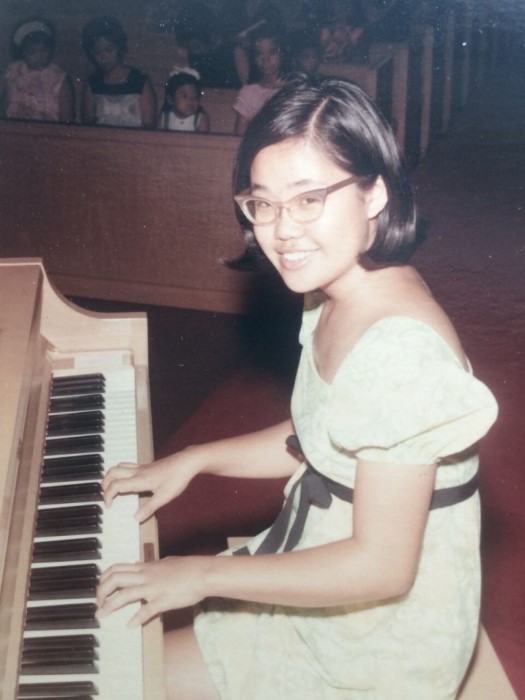
My music training has focused on Western/European classical music. I have an undergraduate degree in composition, and graduate degrees in composition and arts administration. I met my husband at the University of Iowa, where we both pursued our music degrees. His faculty appointment at the University of Minnesota led us to the Twin Cities, where we have raised our two children and pursued our life work.
I started out as an administrator for the Greater Twin Cities Youth Symphonies and, after the birth of our first child, went back to school to pursue my music therapy certification. I gave birth to our second child in the middle of my doctoral program in music therapy. After a 6-month internship in Tallahassee, FL, I was hired as the first music therapist on staff at Reuben Lindh Family Services in Minneapolis. This large human services agency served young at-risk children and their families. My time there was busy and fulfilling.

When did you start to think about making a change in midlife?
At age 43, I was in a good place. My music therapy work was challenging, my family life was stable, and I was finally able to lift my head a bit and take a look out there. Coming to the Midwest was a culture shock in the beginning, but I embraced my new environment wholeheartedly. Having children, though, and watching them grow up in a culture so different from my own was the impetus for me to sign up for a taiko class—a modern drumming style with roots in multiple Japanese music and theatrical forms. I was hooked after my first lesson.
About five years into my taiko training and performing, I remember sitting in the front of the television and watching one of my favorite videos. It was a documentary about Kodo, the internationally acclaimed taiko performing group from Sado Island, Japan. “Kodo: Heartbeat Drummers of Japan” beautifully illustrates the group’s story of sacrifice, complete devotion, discipline, and the continuing development of artistry. I’ve always followed the career of one of the few female Kodo members in particular, Chieko Kojima. I had seen her perform in Los Angeles a couple of years before; her musicality, technique, and stage presence was everything I strived for.
As the film showed Kojima and other Kodo members going about their activities of communal living coupled with grueling training, I broke down and cried. I had finally found my “it” in life; this is what I was born to do. But how? I was too old; there was no way I would abandon my family; why was I always too late? At the very least, though, I would somehow find a way to make taiko my life’s work, here in Minnesota’s tiny Japanese/Japanese American population.

What is your next act?
![e-MA-TaikoAlive![1]](https://helenetstelian.com/wp-content/uploads/2016/06/e-MA-TaikoAlive1-300x149.png) I am the founder of ensemble-MA. We are a group of friends whose mission is to connect with audiences through our unique blend of Japanese, Japanese American, and Asian American influenced music. We have a special focus on reaching out to older adults, especially those for whom health and mobility issues isolate them somewhat from the greater community. TaikoAlive!, the educational side of ensemble-MA, shares its music and dedication with all individuals or groups interested in the art of taiko, with a special focus on teaching taiko to older adults. It’s been a challenging, enriching, and transformative experience for both the participants and the instructors.
I am the founder of ensemble-MA. We are a group of friends whose mission is to connect with audiences through our unique blend of Japanese, Japanese American, and Asian American influenced music. We have a special focus on reaching out to older adults, especially those for whom health and mobility issues isolate them somewhat from the greater community. TaikoAlive!, the educational side of ensemble-MA, shares its music and dedication with all individuals or groups interested in the art of taiko, with a special focus on teaching taiko to older adults. It’s been a challenging, enriching, and transformative experience for both the participants and the instructors.
The part of this taiko life I enjoy the most continues to be the connection with students and with audiences. I love to talk with folks after a class or a performance to discover what they felt, heard, or saw. Taiko is a powerful, visceral experience. It is not uncommon for someone to walk up to the group with, “I started crying, and I don’t really know why!”
How did you become a full-time taiko performer?
At this point, I had been playing for five years, and was a founding member of Mu Daiko. I called the then Theater Mu, the organization that was sponsoring the taiko group and classes the day after I watched the documentary. (Theater Mu eventually changed its name to Mu Performing Arts in order to acknowledge the viablity of Mu Daiko). The timing couldn’t have been more perfect; they were planning to add a part-time audience development staffer for the theater side of the operation and my name had come up as a possibility.
Over time, and as the taiko program expanded, the job morphed into a full-time administrative position. I taught classes and residencies, arranged and performed for the big annual concerts and the hundreds of smaller, outreach performances in between. I dealt with costumes, personnel, union issues, fundraising, grant writing, and became the organization’s chief liaison with the greater taiko world. I composed for the group, and eventually became its Artistic Director.
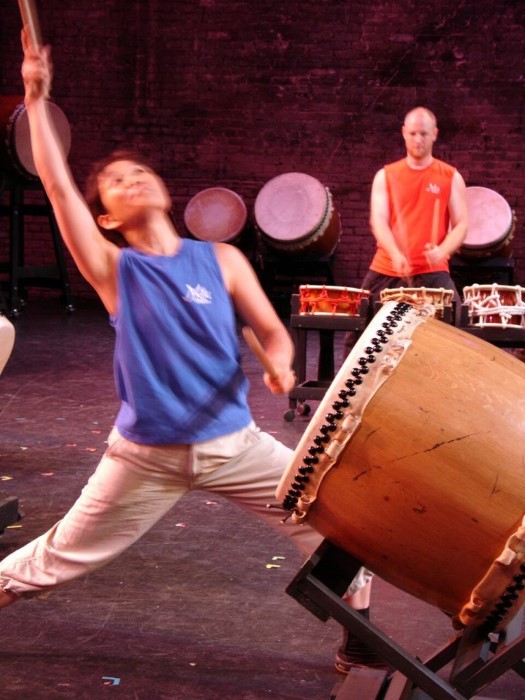
Mu Daiko Dress Rehearsal
Why did you choose this next act? How hard was it to make the transition?
There was no other option, really. As much as I loved my work as a music therapist, and as overly dramatic as this sounds, I felt my soul was dying a little bit when I couldn’t practice or play. It was everything rolled up into one—music, rhythm, culture, movement and connection.
It was surprisingly easy to make the transition from full-time music therapy director to part-time audience development staff. My not-so-secret goal was to help taiko establish its place within the organization and to eventually segue my job responsibilities to everything taiko. My education and hands-on experiences as manager for the youth orchestras stood me in good stead. And as I began working with different people—personnel and audiences—my music therapy observational skills helped me become a responsive teacher and developer of taiko talent.
How supportive were your family and friends?
This was a huge life change, not only for me, but for my husband and children as well. We would be losing income, and it was going to mean tightening the financial belt so that I could pursue this passion. And it would not have been possible without my husband’s complete emotional and financial support. My friends were also supportive; most had seen me in performance and could see the potential it held for me personally and as a great expression of the Japanese American experience.
There was less time with kids, for sure, though I never heard a word about my absences. Gone was the 8-4, Monday-Friday predictable work schedule. I was able to be more available during the workweek, but evenings and weekends were now taken over by teaching or performing. My daughter has told me on more than one occasion of how proud she was of my taiko work, but I still have lingering guilt about the amount of time I lost with them, time that can’t ever be reclaimed.
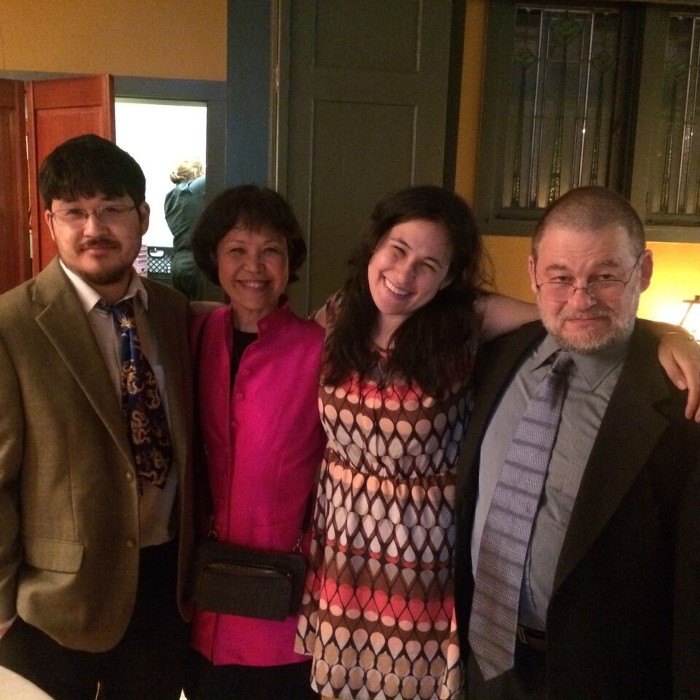
Recent family photo
What challenges did you encounter?
Personally, there were financial challenges, at least in the beginning. We like to joke that though we were professionals with advanced degrees, we were still living like graduate students. I still don’t think we’ve left that mentality, even now 14 years after that first big change.
There were always challenges at the workplace to face and overcome. Was taiko a legitimate art form to be developed alongside theater (the original organization), or was it an aside to the mission of the organization? There was a branding change early on during my tenure that recognized taiko’s contributions to the organization. And I was excited and grateful that taiko had been given de jure a full membership status within the organization. But, de facto, it became clear to me that taiko would always be the little kid forever tugging on theater’s coat tails.
Because we were embedded within a theater organization, the theatrical was embraced and influenced taiko greatly. I worked hard to balance this approach with my own training in music. Regular rehearsals became standardized and personal practice was encouraged. We were trying to get to the next level as an ensemble, and no amount of staging was going to help us make better music. The most difficult piece for me to deal with was time. I was giving so much to teaching, performances, and administration and had little or no energy for creative work.
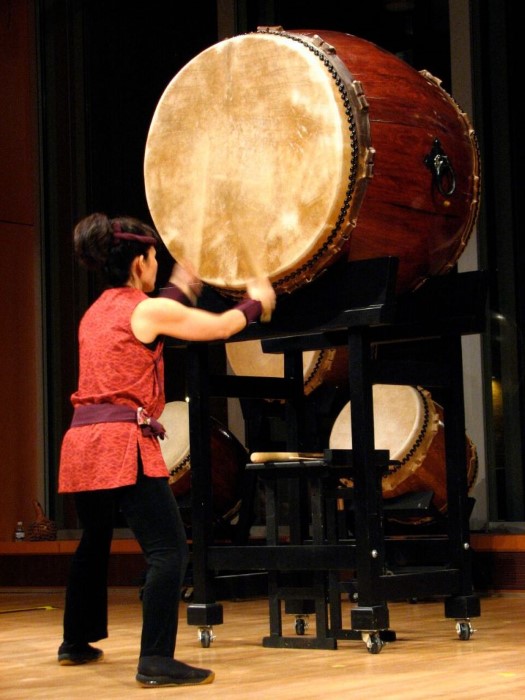
“Blessings” solo Odaiko performance
Were there times when you thought about giving up?
Towards the end, faced with an impending leadership change in the organization, I thought about walking away. There had been cuts, the organization was still working its way out of the crash, and there were subtle and not-so-subtle hints that taiko’s position in the organization was shifting. Again, it was the folks I worked with who gave me enough energy to hang in for one more year. You never forget that look in someone’s eyes when they have made their own taiko discovery.
After the new leadership was in place, the hints became realities, and in my mind there was no future with this organization. I discovered that I needed to leave for my own emotional health. When you’re the engine of any group and faced with decreased supportive fuel coming from the sponsoring organization, you inevitably conk out.
What did you learn about yourself through this process?
I learned that I was able to take risks and come out the better for it. I learned that I’m a super-sensitive person—an asset and a detriment both. I learned that I could learn something new in my 40s and develop it into another journey.
There were discoveries to be made—about latent creative and performing desires; about some kind of meaningful connection with my ancestral Japan; about significant connections with an audience—it was like uncovering your own personal gold mine of insights and realizations.
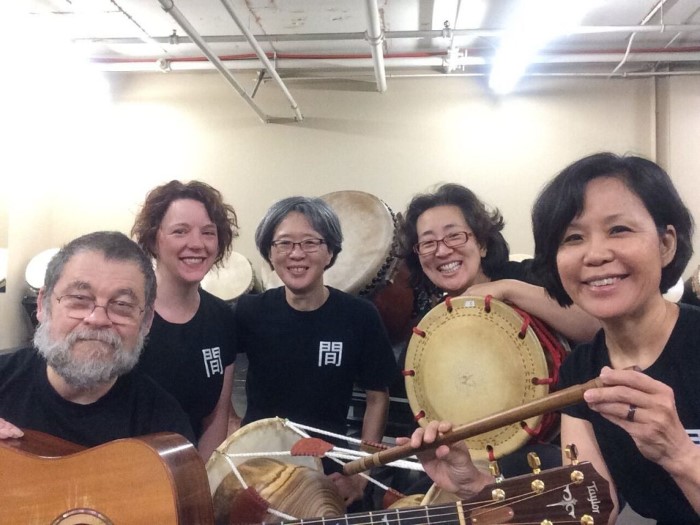
Ensemble-MA members
Looking back, is there anything you’d have done differently?
I would have made more of an effort to balance my home and work life. I wish I could have chosen my family over taiko at times. In the early stages of any artistic group, you’ve got to take every opportunity offered in order to get it off the ground. Fewer sacrifices on my part would not have hurt the bottom line, or someone else might have been encouraged to pick up the slack.
What advice do you have for women seeking reinvention in midlife?
If the opportunity presents itself, take it! Just go in with your eyes wide open, especially if you are looking to fulfill a passion.
Before any kind of big change, make sure you really know yourself—what are your strengths, what are your challenges, how do you learn, how have you handled stressors in the past. List all of the ways in which this will affect your day-to-day life and activities, especially if you have children.
Be assertive, be confident in your abilities and what you have to offer. Be very clear on why you are doing what you are doing.
What resources do you recommend?
The Third Chapter: Passion, Risk, and Adventure in the 25 Years After 50 by Sara Lawrence-Lightfoot.
The Gifts of Imperfection: Let Go of Who You Think You’re Supposed to Be and Embrace Who You Are by Brene Brown.
The Creative Habit: Learn It and Use It for Life by Twyla Tharp.
I also love this quote from Martha Graham and have it framed above my desk.
“There is a vitality, a life force, an energy, a quickening that is translated through you into action, and because there is only one of you in all of time, this expression is unique. And if you block it, it will never exist through any other medium and it will be lost. The world will not have it. It is not your business to determine how good it is nor how valuable nor how it compares with other expressions. It is your business to keep it yours clearly and directly, to keep the channel open. You do not even have to believe in yourself or your work. You have to keep yourself open and aware to the urges that motivate you. Keep the channel open. …No artist is pleased. [There is] no satisfaction whatever at any time. There is only a queer divine dissatisfaction, a blessed unrest that keeps us marching and makes us more alive than the others.”
And another quote from my therapist: “I’m perfectly fine. I just don’t know it yet.”

Intro to Taiko Class
How does one learn more about taiko?
Taiko Community Alliance: I was a founding member of this new nonprofit that serves the entire taiko community in the United States and Canada.
For classes, workshops, performances:
Taiko Center of the Pacific
What’s next for you?
I’m three years into my third act. It’s taken a while for me to decide what I want and need. I’ve formed my own taiko-based ensemble; I’m composing; I’m using my music therapy skills as I work with older adults in a variety of community settings and facilities.
I continue to struggle with balance; I continue to struggle with my own self-imposed ageism. I’m divinely dissatisfied. I’m a little less driven and willing to relax into this next phase.
Opportunities keep presenting themselves to me, and I’m able to decide what will be the best for me. And I’m still deciding what I want to be when I grow up.
Contact Iris Shiraishi at ensemblema@gmail.com
www.ensemblema.org
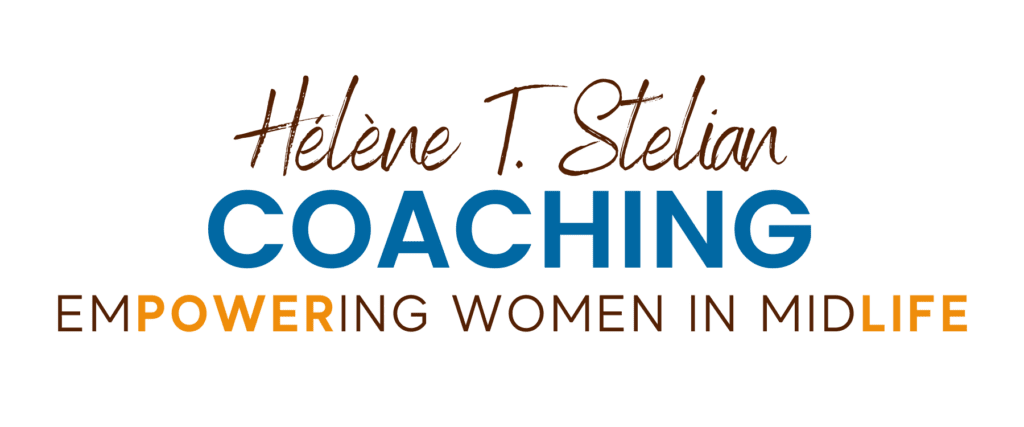
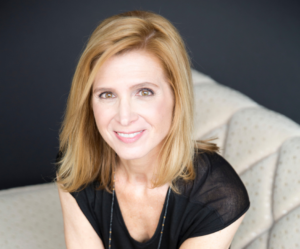




Amazing! And utterly inspiring!
(with head bowed) Thank you, Diane! I can’t ever say that my life has been dull, by any means!
So incredible. Wish I could see a live performance.
Let me know what part of the country you’re in! If not ensemble-MA there are many wonderful taiko groups across the U.S. and Canada always ready to give inspiration! Thank you!
I have checked your website and i have found some duplicate
content, that’s why you don’t rank high in google, but there is a tool that can help you to create 100% unique content, search
for; Boorfe’s tips unlimited content